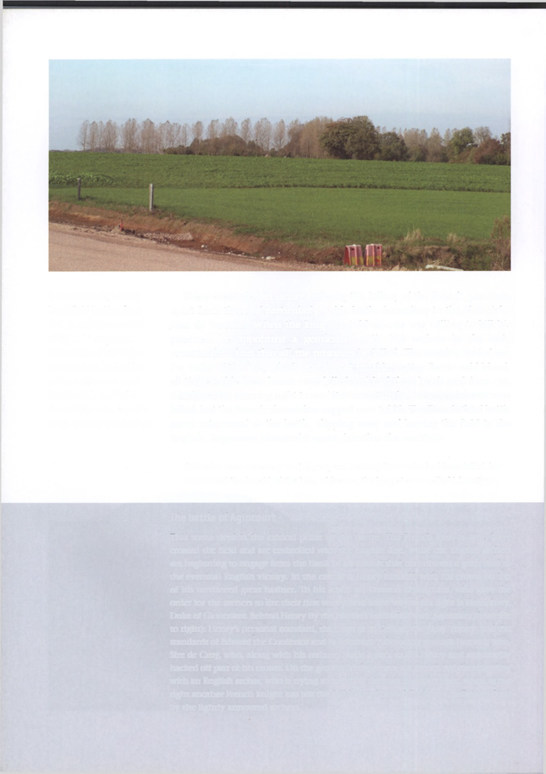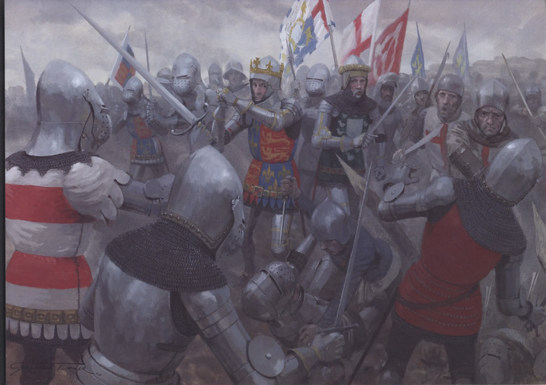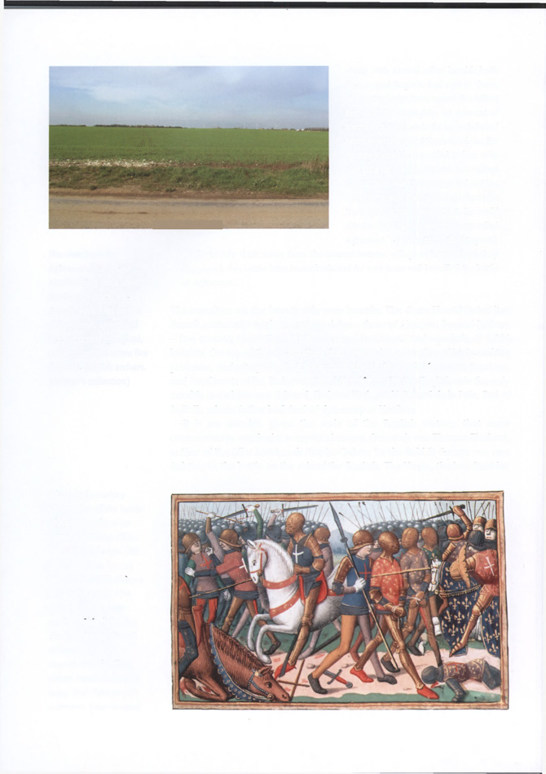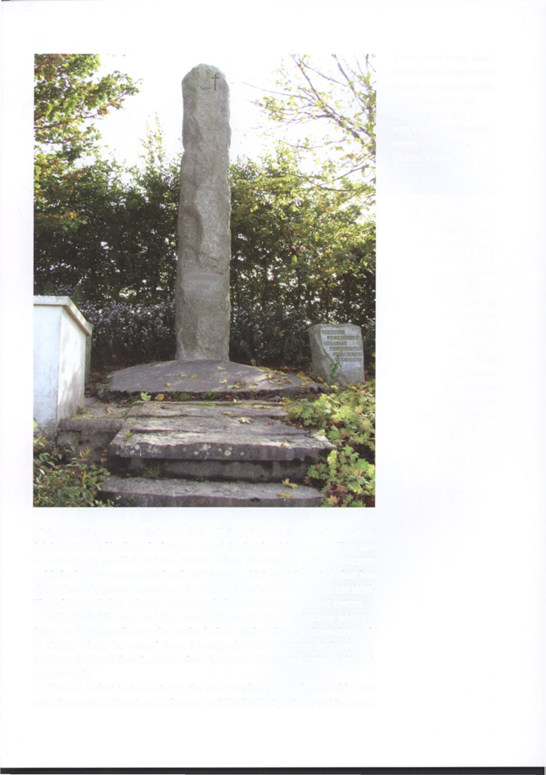Henry V: The Background, Strategies, Tactics and Battlefield Experiences of the Greatest Commanders of History Paperback (12 page)
Authors: Marcus Cowper
Tags: #Military History - Medieval

15th-century illustration
flight away from the enemy. Because of the example they set many of the
of the battle of Agincourt,
French left the field in flight.
showing the castle in the
Soon afterwards the English fell upon them body on body. Dropping their
background, from the
bows and arrows to the ground, they took up their swords, axes, hammers,
Abrege de to Chronique
falchions and other weapons of war. With great blows they killed the French
d'Enguerrand de Monstretet
who fell dead to the ground. In doing this they came so far forward that they
(Ms.frangais 2680,
almost reached the main battle, which was following in behind the vanguard.
fol.208r) held in the
After the English archers the King of England followed up by marching in with
Bibliotheque Nationale,
all his men-at-arms in great strength.
Paris. Enguerran
Monstrelet was a
The intervention of the lightly armoured and manoeuvrable English archers Burgundian chronicler
appears to have been crucial in what was a hard-fought battle. Sources on active at the court
both sides relate that piles of bodies built up around the various royal and of Philip the Good,
aristocratic standards in the English front line, with Henry himself supposed Duke of Burgundy.
to have protected the wounded body of his brother Humphrey, Duke of (akg-images/Jerome
Gloucester, and to have lost a fleuret from the gold crown of his helmet.
da Cunha)
Despite the fierce nature of the fighting, the first two
French battles were defeated and their leaders
either killed or captured. However,
the final and most controversial act of
the battle was yet to come. When the
English began rounding up their
numerous prisoners the rumour went
round that the as-yet-uncommitted
French third battle was entering the
fray. This third force was so numerous
as to be a threat to the English
position, particularly as they had a
large number of prisoners to their
rear. At the same time a further
French cavalry force attacked the
English baggage and camp, capturing
part of the royal treasure.
33


A view of the Agincourt
These events led to Henry ordering the killing of the French prisoners,
battlefield looking from
apart from those of particularly noble birth. According to the chronicler
Maisoncelle towards the
Jean de Waurin: 'When the king was told no-one was willing to kill his
village of Tramecourt.
prisoners he appointed a gentleman with 200 archers to the task,
At the time of the battle
commanding him that all the prisoners be killed. The esquire carried out
the woods on both sides
the order of the king which was a most pitiable matter. For in cold blood,
of the battle were much
all those noble Frenchman were killed and had their heads and faces cut,
thicker and provided a
which was an amazing sight to see.' It is uncertain how many prisoners were
flank defence for Henry's
killed, but the French chroniclers suggest over 1,000. The French third battle
army. (Author's collection)
never intervened in the battle, slipping away and leaving the field to the
English. Enguerran Monstrelet again describes the reaction:
Whilst his men were busy in stripping and robbing those who had been killed, he
summoned the herald of the king of France, the king at arms called Mountjoye,
The battle of Agincourt
This scene depicts the critical point of the battle. The French men-at-arms have
crossed the field and are embroiled with the English line, while the English archers
are beginning to engage from the flank in an assault that contributed a great deal to
the eventual English victory. In the centre is Henry himself, with his crown on top
of his unvisored great basinet. To his left is Sir Thomas Erpingham, who gave the
order for the archers to fire their first volley, and some way to his right is Humphrey,
Duke of Gloucester. Behind Henry fly the banners associated with Agincourt (from left
to right): Henry's personal standard, the cross of St George, the Holy Trinity, and the
standards of Edward the Confessor and St Edmund. Advancing towards Henry is Jean,
Sire de Croy, who, along with his retinue, made a pact to kill Henry and supposedly
hacked off part of his crown. On the ground in the centre is a French knight struggling
with an English archer, who is trying to stab him through his open visor, while to the
right another French knight has felt the full force of one of the heavy mallets wielded
by the lightly armoured archers.
34




along with several other heralds both
French and English, and said to them,
'It is not we who have caused this killing
but God the Almighty, on account of
the sins of the French, for so we believe.'
Later when he asked them to whom the
victory should be accorded, to him or to
the king of France. Mountjoye replied
that to him was the victory and not the
king of France. Then the king asked him
the name of the castle which he could
BHHHHHHR
see close by. They answered it was called
Agincourt. 'As all battles', the king said,
The view from the
ought to take their name from the nearest fortress, village or town where they
Agi n co u rt-Tra m eco u rt
happened, this battle from henceforth and for ever more will be called the battle
road Looking back towards
of Agincourt.'
the French Lines. The
French advanced across
The casualties on the French side were horrific. The
Gesta Henrici Quinti
lists
this ground, which had
French aristocratic fatalities as three dukes - those of Alengon, Bar and Brabant
been recentLy ploughed,
- five counts, more than 90 barons and bannerets and upwards of 1,500
under constant arrow fire
knights. On top of these casualties there were also a number of high-ranking
from the English archers.
prisoners, including Marshal Boucicaut, the Dukes of Orleans and Bourbon,
(Author's collection)
and the Counts of Eu, Richemont and Vendome. On the English side the only
notable casualties were Edward, Duke of York, and Michael de la Pole, Earl of
Suffolk, whose father had died of dysentery at Harfleur.
It is no wonder, given the scale of the English victory, that some
commentators ascribed it to mystical causes. One such was Thomas Elmham,
author of the
Liber Metricus de Henrico Quinto
: 'In the field St George was seen
fighting in the battle on the side of the English. The Virgin, the handmaiden
A late 15th-century
illustration of the battle
of Agin court from
Les
Vigites de Charles VII
by
Martial d'Auvergne (Ms.
francais 5054, fol.ll)
held in the Bibliotheque
Nationale, Paris. This
illustration focuses
on the melee following
the French assault and
depicts an English
man-at-arms leading
bound French prisoners
away, their fate as-yet
unknown, (akg-images)
36
